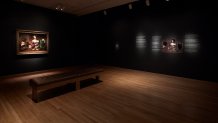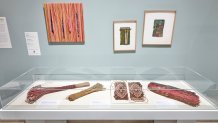The great joy of visiting an encyclopedic museum like the Dallas Museum of Art (DMA) is discovering masters of different mediums and eras in one outing. That is especially true with two exhibitions now on display at the DMA.
Caravaggio's "Martha and Mary Magdalene" is presented in an intimate display through Sept. 22. "Sheila Hicks: Secret Structures, Looming Presence" is on view through Jan. 12.
Caravaggio's "Martha and Mary Magdalene" is a special treat for Texas art lovers. On loan from the Detroit Institute of Arts, it is one of fewer than ten Caravaggio paintings on view in the U.S.
The painting is an early work from a Baroque master who is as famous for his hot temper as his work. Born in Italy in 1571, Michelangelo Merisi da Caravaggio was known for his brawling, even throwing a plate of artichokes at a waiter who displeased him and killing a man after a tennis match.
"His biography really is a collection of stories that are found in police reports at the time," Julien Domercq, the DMA's new Lillian and James H. Clark Assistant Curator of European Art, said.
At first glance, "Martha and Mary Magdalene" does not reflect the artist's notorious rap sheet. "Despite his incredibly tumultuous life, you get canvases like this which are so subtle, beautiful and quiet," Domercq said. "But when you get closer, you'll see they are painted incredibly freely. Caravaggio worked straight on the canvas. He didn't bother with doing preparatory drawings. He had his sitters sitting in front of him and attacked the canvas with his brush. He paints with instinct."

This work demonstrates Caravaggio's use of dramatic lighting effects created by sharp light and dark contrasts, known as chiaroscuro, to elevate a conversation between sisters to something extraordinary. Martha is pictured counting out the sins of Mary Magdalene, a woman the Catholic Church branded a prostitute at the time, when the wayward sister experiences a spiritual awakening.
The Scene
"What is fascinating to me about this picture is that there is nothing really to tell you that this is a religious scene. There are not the usual attributes of a religious scene. There is no halo above her head and yet you know that there is something holy about it," Domercq said. "It's this ability to represent the religious story in a completely novel way in the contemporary world around him."
The light itself signifies the holy presence in the scene. A sumptuously dressed Mary Magdalene is bathed in an ethereal glow while Martha's face is in shadow. A mirror, the ultimate symbol of vanity, does not reflect either of the sisters. Instead, it reflects the source of transcendent light.
"Light in Caravaggio is never accidental," Domercq said. "For Caravaggio, light has deeper metaphysical significance and here it is that divine revelation."
Upstairs on view in the DMA's Arts of the Americas Andean gallery and Atrium Overlook is a demonstration of a contemporary artist's admiration of ancient traditions. "Sheila Hicks: Secret Structures, Looming Presence" pairs the 84-year-old artist's work with works from the DMA's collection of ancient Andean art.
"A portion of her vast body of work is a dialogue between past and present. This gives us an opportunity to examine both her practice and ancient fiber arts from a different perspective," Michelle Rich, the DMA's Ellen and Harry S. Parker III Assistant Curator of the Arts of Americas, said.

Displayed with ancient Peru cloths created with four finished edges are small woven squares Hicks calls "minimes." Hicks creates these small pieces everywhere, even working on them during long flights. On display is one of Hicks' early minimes created in 1966. "I love how the lighting shines on it, and you can see the beautiful texture of the piece. It looks almost topographic when you're standing at a distance," Rich said.
Wrapping and bundling played practical and sacred roles in indigenous communities across the Americas. Ornate shin guards and trees from a figural scene reflect the functional and important use of this creative output. Hicks' "Zihzabal," a work purchased in April at the Dallas Art Fair, evokes this tradition with its wrapped bamboo sticks. "It really demonstrates Sheila's reverence for the practices of the ancient Andean society."
MORE: DMA.org



